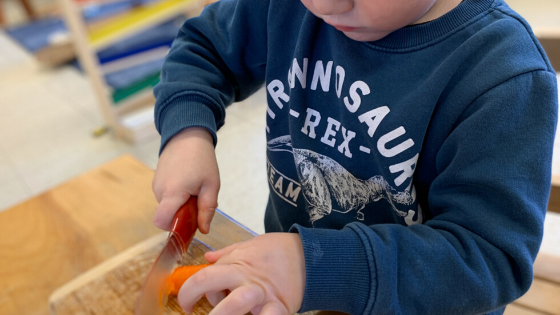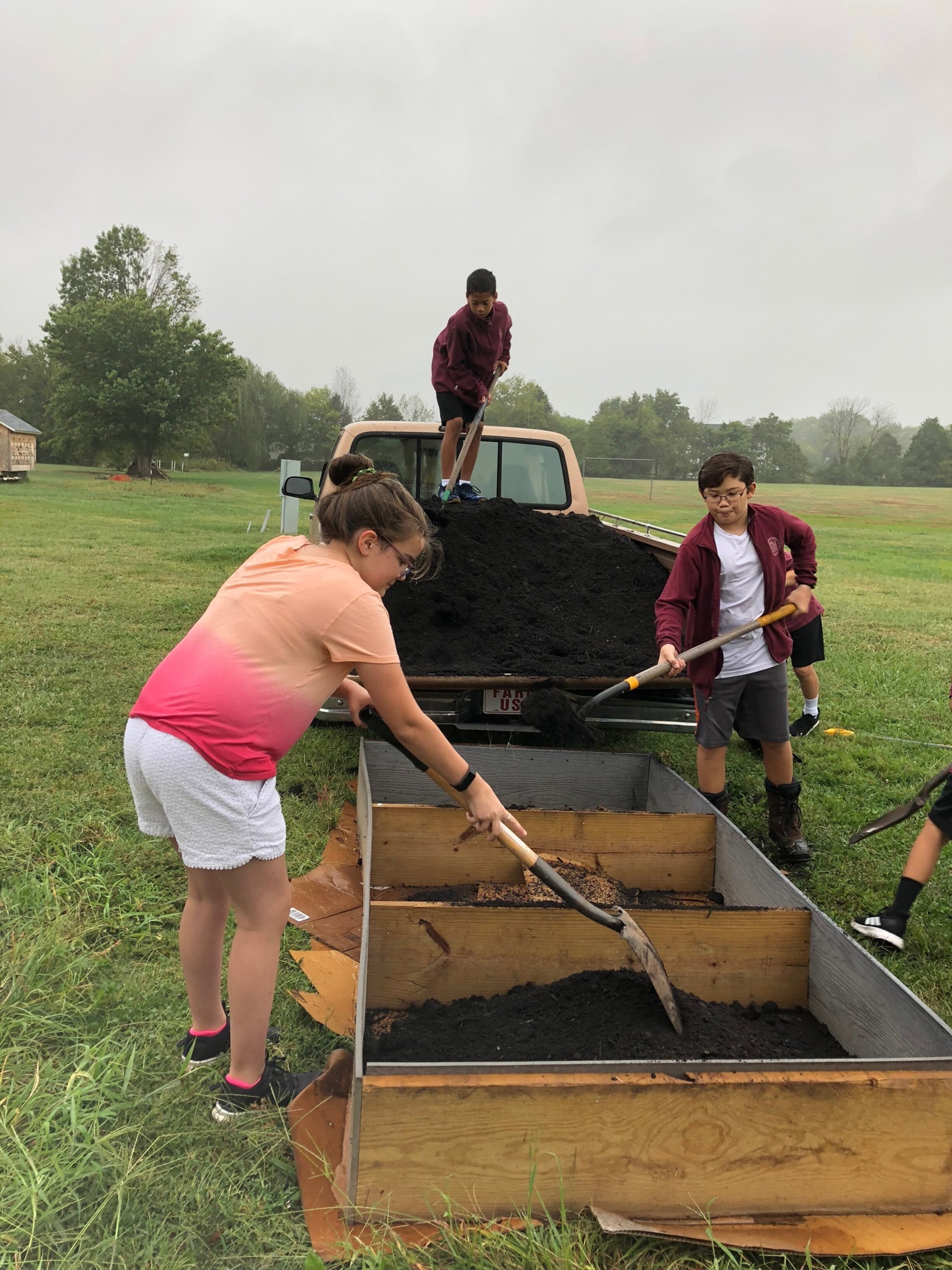Dr. Maria Montessori created her methodology over a century ago, and those of us who study her work and practice her ideas know it really works for children, even all these years later. Like any specialized approach or body of work, Montessori education incorporates unique terminology. Curious to learn more about what we mean when we say normalized, concrete and abstract, or false fatigue? Read on to learn more (and bookmark this post for future reference)!
Casa dei Bambini
This was the name of the first school Dr. Montessori opened in Rome, Italy. It translates to children’s house, and references a Montessori class for 3-6 year olds. Other names for classes for this age group include casa, primary, children’s house, or early childhood. Casa classes are a combination of preschool and kindergarten.
concrete & abstract
Dr. Montessori believed that “the hand is the instrument of the mind.” She understood that children learn best by doing first and internalizing later. In Montessori classrooms, we give children specialized learning materials that they manipulate with their hands to begin grasping various concepts. Over time, they use materials that are less concrete, and require more abstract thinking, until they are eventually able to master a skill without the use of any material at all.
control of error
One hallmark of a Montessori education is supporting children to become independent learners. Most of the materials children use in our classrooms incorporate a control of error; that is there is only one way to correctly use the material. If a child uses a material incorrectly, they will not be able to complete the activity, and will understand they have made a mistake somewhere along the way. An opportunity is provided naturally: instead of a teacher correcting a child and telling them what to do differently, the child is able to self-assess and determine what changes they need to make on their own.
cosmic education
During the elementary years, children begin seeking out answers about the universe and their place in it. It is our job to provide children with lessons and experiences at this age that aim to satisfy their curiosity, and to give them a deeper understand of the interconnectedness of all things. We call this broad study cosmic education. Elementary classrooms use special impressionistic lessons to inspire children as they explore concepts such as the creation of our universe, the evolution of life on earth, the evolution of humans, and the origins of math and language.
Erdkinder
This was the name Dr. Montessori gave to her ideas about education for adolescents. The German word for Earth-Children, she felt we should focus less on testing and college preparation and more on self-sufficiency. Erdkinder programs are traditionally run as farms that serve as micro-economies, with the students running and managing all aspects of operations. Today, some Erdkinder programs interpret the ideas differently, with students running a variety of small businesses themselves. Traditional learning is also an element of the program, and real-life experiences are often closely connected to any classroom experiences.
false fatigue
In Montessori classrooms we set aside a large chunk of time (3 hours for children 3 years of age and older) each day in which they receive lessons and work independently. (Learn more about this in the definition of work period below.) At a certain point during the course of this time, an adult observing will begin to notice the volume in the classroom beginning to rise, social activity beginning to increase, and an apparent decrease in productivity. Our task is to pause, wait, and watch for the flow of the room to return naturally to its previous state. We all need a break once in a while, and it is normal to expect that children will, at some point, need to step away from the work they have been deeply engrossed in. In the long run, this false fatigue break actually allows them to be more productive and focus better once they return to their work.
grace & courtesy
This phrase is applied to the approach Montessori schools have when teaching children how to interact with others. Manners play a part of this work; we explicitly teach children how to say please, thank you, excuse me, and you’re welcome, but it’s also so much more. We teach children how to navigate friendships, how to resolve conflict, how to express gratitude, and how to share their own feelings.
guide
While the term teacher is sometimes used, many Montessori schools opt for the term guide. Our educators do not stand in the front of the classroom and impart their knowledge upon students in conventional ways. We don’t feel that our task is to give them information, but rather to lead them toward it so they may discover it themselves. The term guide is much more fitting. Another traditional term that is sometimes used in our schools is directress.
Nido
Nest in Italian, this is the term Montessori uses for the infant program. Nido classrooms are nurturing and secure, giving babies a safe and comfortable place to begin their exploration of the world.
normalized
When Dr. Montessori began using this word to describe children a century ago, it was used with a very positive connotation. When a child is normalized, it means they have embraced to ability to learn independently within the Montessori classroom; they are able to enter the environment confidently, select work that interests them, and complete it with concentration and perseverance. That is not to say they never feel struggle or frustration, they have simply internalized the expectations of the environment and are joyful learners in the community.
planes of development
As a scientist, Dr. Montessori carefully studied patterns in children’s learning. Her observations led her to notice specific planes, or stages, of development. Each plane is marked by very specific differences in the way children view the world and learn from it. Having this information assists educators in creating environments and utilizing approaches that teach the child according to how they are developmentally prepared to learn. The first plane includes children ages 0-6, the second plan 6-12, the third 12-18, and the fourth 18-24.
practical life
We make it a point to teach children a range of skills they will need to be successful. While math, language, and science certainly make the cut, there’s a lot more to life than traditional academic subjects. Practical life exercises teach children how to clean up after themselves, how to feed themselves, or how to do any number of tasks that are required of us as we grow to become independent humans. We do not give children pretend food to cook with or play tools; we give them beautiful, sturdy, child-sized versions of the real thing. This allows them to take this practice seriously, and to know that we take them seriously, too.
prepared environment
This is typically what we use to refer to our classrooms, but the term could actually be applied to just about anywhere. When a Montessori adult takes special care in creating a space that serves the child in their developmental stage and allows them to explore and learn independently, they have prepared the environment.
sensitive period
During her years of observation, Dr. Montessori noticed that children went through typical periods in which they seemed primed and ready to learn specific things. While there is of course some variability, Montessori guides know when to expect children to be ready to learn early math skills, beginning language work, gross motor skills, and so much more. If we introduce a skill too early a child is likely to become overwhelmed and frustrated, if we miss the window, or sensitive period, the child is likely to have lost interest to an extent.
sensorial
Montessori toddler and primary classrooms provide children with a series of lessons and materials that allow them to refine their various senses. These are referred to as sensorial materials, and help children learn differences in weight, size, color, shape, scent, sound, and more.
three-period lesson
The three-period lesson is one way Montessori guides present information and assess comprehension. The first time information is presented to the child, the guide names it. For example, “This is the gill of a fish.” The second time (perhaps the same day, perhaps not), the guide will point to a picture and ask the child, “Where is the gill?” The third, and final period consists of the guide asking, “What is this?” when they point to the gill. This strategy may be used for presenting and assessing a wide range of skills.
work
Any time a child is focused on a learning activity we refer to this as work. This does not mean the child must be writing something down on a piece of paper, in fact more often they are not. We recognize that work looks different at different ages, and we honor its importance regardless.
work period/cycle
Montessori schools utilize a three-hour period of time each morning in which children are able to dive deeply into their work. We recognize that it can take some time to settle into the flow of the day, and giving children this gift of time allows them to fall into stronger patterns of learning and independence. Older children often have a second work period/cycle during the afternoon.









